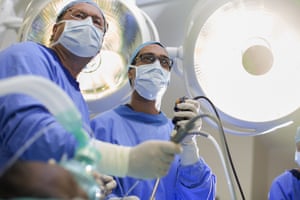Often dismissed as ‘women’s troubles’, endometriosis affects one
woman in 10 of reproductive age, yet a lack of research and funding
means sufferers can live in severe pain, unable to work or socialise
 The hidden toll and extraordinary neglect of a disease that affects
an estimated 176 million women around the globe, causing many to suffer a
life of pain and debilitation and sometimes infertility, is revealed by
the Guardian. One woman in 10 of reproductive age has endometriosis, it is
estimated, and yet often their primary care doctors do not know what it
is and the specialists to whom they are sent are ill-informed. Vast numbers of women are under-treated or badly treated. It can take
years to get a diagnosis and during that time women may suffer severe
pain and are unable to work, socialise or maintain a sexual
relationship.
The disease does not always have symptoms and may be the cause of half of all unexplained infertility.
The hidden toll and extraordinary neglect of a disease that affects
an estimated 176 million women around the globe, causing many to suffer a
life of pain and debilitation and sometimes infertility, is revealed by
the Guardian. One woman in 10 of reproductive age has endometriosis, it is
estimated, and yet often their primary care doctors do not know what it
is and the specialists to whom they are sent are ill-informed. Vast numbers of women are under-treated or badly treated. It can take
years to get a diagnosis and during that time women may suffer severe
pain and are unable to work, socialise or maintain a sexual
relationship.
The disease does not always have symptoms and may be the cause of half of all unexplained infertility.Endometriosis has existed in the twilight for centuries because of society’s reluctance to discuss what was euphemistically known for so long as “women’s troubles”.
It occurs when tissue similar to the lining of the womb is found elsewhere – most commonly in the abdomen, ovaries, in the recto-vaginal septum, bladder and bowel. That tissue behaves like the lining of the womb, bleeding every month, and can cause cause severe and chronic pain . Women tell of such acute pain that they pass out.
The lack of research and funding for a disease that affects so many women is “a major scandal”, said Lone Hummelshoj, who heads the World Endometriosis Research Foundation and the World Endometriosis Society.
“Endometriosis affects women in the prime of their life. It is not a lifestyle disease. It is not a disease you get later in life. It attacks teens, young women when they should be out being active, working, having children, having sex – 50% of them are struggling with sex because it is too painful,” she said.
It has exacted a massive social cost in broken marriages and depression as well as being a huge economic burden, partly because of the large number of women who have to drop out of the workforce.
In the US, with 7.6 million women affected, the estimate was €70.9bn (£52.1bn, $80.4bn) a year; in the UK, which has 1.6 million sufferers, the cost was estimated in 2012 at €14.4bn (£10.6bn). In Australia, there may be 550,000 women affected, costing the economy A$6bn (£2.75bn).
The numbers are comparable to diabetes – and yet there is only a fraction of the awareness of the condition and help for those afflicted.
Far too many women are turned away by their doctors and told they must put up with the pain or even that they are imagining it. A Guardian online call-out to women for their stories got 600 responses in one day. A recurring theme was: “The doctors thought it was all in my head”.
Niki Dally, 33, in Wales, UK, has been suffering from endometriosis from the age of 11. She said even her mother thought she was making it up. “My mother thought I was a hypochondriac,” she said.
“One doctor said ‘it’s in your head, girl. You have got to deal with it.’” She was prescribed medication for her nausea and vomiting and told it was irritable bowel syndrome, cysts, a UTI, eating disorders and depression.
“Aged 14, the doctors thought it might be appendicitis and admitted her to hospital. It took 10 years to get the right diagnosis, but she now lives on a cocktail of strong painkillers and is still struggling to get the right treatment”.
In the US, Heather C Guidone who works at the Center for Endometriosis Care, Atlanta, Georgia, and has herself been through 22 operations for severe endometriosis, said women are still told periods are supposed to hurt and that it’s a woman’s lot in life to suffer. “All of those cliches that have surrounded menstruation since the dawn of time. [A woman tells the doctor] ‘I have this horrible life-altering pain, and these symptoms’, then the doctor will kind of pat her on the head and say take this pill. Then you’ve got this vicious cycle, and ultimately she stops telling people.”
“Every, every possible misdiagnosis is brought on some of these women before the correct diagnosis is made. And the traumatic assertions that you’re having pelvic pain because you have an STD – the whole thing is bizarre.
Endometriosis can be mild or so severe that it takes over a woman’s life. Former Spice Girl Emma Bunton, Dolly Parton and Anna Friel all have endometriosis. So does Booker Prize-winning author Hilary Mantel and actors Susan Sarandon and Whoopi Goldberg. Marilyn Monroe is thought to have become addicted to the painkillers she took for endometriosis, which resulted in her death.
 Experts say the disease is little known. “The people we have polled
have never heard of it,” said Jane Hudson Jones, chief executive of the
charity Endometriosis UK. “I have never come across anybody in the
general public who knows about it. Yet it can be absolutely
devastating.” Surveys of their own membership showed that 25% had felt
suicidal because of it. “It can affect pretty much every area of your
life – your work, career, income, relationships and fertility. And many
are constantly in pain.” Advertisement Carol
Pearson, 43, had to give up the successful career she loved because she
was too ill too often. “I hated losing my career,” she said. “I worked
my socks off to get to university and become a chartered accountant. I
was in a management position for many years and paying taxes. I worked
for my company for 13 years and they did everything they could to keep
me at work.” But after extensive surgeries to the bowel and bladder,
which did not heal well, resulting in emergency trips to hospital in an
ambulance on more than one occasion, everybody realised her career and
her condition were incompatible.
Experts say the disease is little known. “The people we have polled
have never heard of it,” said Jane Hudson Jones, chief executive of the
charity Endometriosis UK. “I have never come across anybody in the
general public who knows about it. Yet it can be absolutely
devastating.” Surveys of their own membership showed that 25% had felt
suicidal because of it. “It can affect pretty much every area of your
life – your work, career, income, relationships and fertility. And many
are constantly in pain.” Advertisement Carol
Pearson, 43, had to give up the successful career she loved because she
was too ill too often. “I hated losing my career,” she said. “I worked
my socks off to get to university and become a chartered accountant. I
was in a management position for many years and paying taxes. I worked
for my company for 13 years and they did everything they could to keep
me at work.” But after extensive surgeries to the bowel and bladder,
which did not heal well, resulting in emergency trips to hospital in an
ambulance on more than one occasion, everybody realised her career and
her condition were incompatible.
 But most gynaecologists do not have the specialist training to remove
the tissue they see, which in severe cases is often very difficult to
access. It often involves the bowel or bladder, which are not parts of
the body gynaecologists usually deal with. Organs can be fused together.
Women tell of having hysterectomies and the wholesale removal of
ovaries and parts of the bowel and bladder, and yet some diseased tissue
remains stuck to nerves and the pain continues. Yet even the most severe cases can do really well with specialist care, said Hummelshoj, who also runs a global information forum.
“Some of them do very well with very good surgery, but unfortunately
that surgery is as specialised as cancer surgery.” In fact, she said,
cancer surgeons had told her it was more difficult. Women need access to
specialist care, not just to a general gynaecologist. “We need to train
these doctors to deal with endometriosis,” she said. Geoff Reid in Australia, one of the leading experts, believes the
disease may be getting more aggressive. “I have been dealing with
endometriosis for 25 years. I just don’t believe that 20 to 25 years ago
we were missing the sort of people that we see today,” he said. “I see
young women in their early 20s with dreadful colorectal endometriosis
and I can’t believe we were missing that. We may have to some extent,
but it is my observation over the years that the disease is becoming
worse. You see some of the most pitiful people with this disease – it’s
awful. People who specialise in endometriosis certainly hare that
view.”
But most gynaecologists do not have the specialist training to remove
the tissue they see, which in severe cases is often very difficult to
access. It often involves the bowel or bladder, which are not parts of
the body gynaecologists usually deal with. Organs can be fused together.
Women tell of having hysterectomies and the wholesale removal of
ovaries and parts of the bowel and bladder, and yet some diseased tissue
remains stuck to nerves and the pain continues. Yet even the most severe cases can do really well with specialist care, said Hummelshoj, who also runs a global information forum.
“Some of them do very well with very good surgery, but unfortunately
that surgery is as specialised as cancer surgery.” In fact, she said,
cancer surgeons had told her it was more difficult. Women need access to
specialist care, not just to a general gynaecologist. “We need to train
these doctors to deal with endometriosis,” she said. Geoff Reid in Australia, one of the leading experts, believes the
disease may be getting more aggressive. “I have been dealing with
endometriosis for 25 years. I just don’t believe that 20 to 25 years ago
we were missing the sort of people that we see today,” he said. “I see
young women in their early 20s with dreadful colorectal endometriosis
and I can’t believe we were missing that. We may have to some extent,
but it is my observation over the years that the disease is becoming
worse. You see some of the most pitiful people with this disease – it’s
awful. People who specialise in endometriosis certainly hare that
view.”
But a study in 2008 by the Belgian gynaecologist Thomas D’Hooghe suggested that endometriosis may be a huge factor in infertility. D’Hooghe’s team carried out laparoscopies on 221 infertile women who had no obvious symptoms. “These were women who regarded their period pain as being normal and 47% of them had endometriosis and 40% of those had stage three and four disease,” said Reid.
“I find that extraordinary. You can have women with really quite bad endometriosis who are essentially asymptomatic, which means putting a handle on the prevalence of endometriosis very difficult. 10% is the figure that is bandied around. What the true incidence is is really difficult to tell.”
Reid says it is really important that women facing surgery for endometriosis on their ovaries are warned of the danger it could affect their fertility, because it can cause their levels of a critical hormone called AMH to fall by between 50% and 70%. “Perhaps they should consider freezing some embryos or eggs,” he said. If asked, he said, “women almost universally want to do that.”
The care women can get varies massively around the world and within countries, and is often dependent on what they can afford. In the US, insurance companies pay the same amount for any endometriosis surgery, regardless of the method or extent of the disease or the specialisation of the doctor.
“You could spend 30 minutes in the operation just burning and zapping and get paid the same amount if you did nine hours doing a meticulous surgery,” said Guidone. “Insurance is not the patient’s friend in this regard.”
That means insurance companies are likely to pay only for a local gynaecologist, who may be unable to unwilling to carry out extensive surgery. Nearly every specialist surgeon the Guardian spoke with had stopped accepting private insurance because of low reimbursement rates.
In the UK, a group of doctors who have become highly skilled in advanced keyhole surgical techniques have set up an accreditation process for hospitals where gynaecologists are treating endometriosis. So far, 45 centres have been accredited by the British Society for Gynaecological Endoscopy.
But patients and some doctors don’t know that high-quality keyhole surgery is available. “If you went up and down the country, you would find a very large number of women who aren’t getting access to this sort of surgery,” said Dominic Byrne, chair of the BSGE’s endometriosis centres and a consultant at the Royal Cornwall Hospitals NHS Trust. “They are told they need an open hysterectomy and their ovaries removed to solve their pain. That would be the most common gynaecological answer to severe endometriosis.”
Sometimes women have had their healthy tubes and ovaries removed, only for the gynaecologist to reach the cervix and find the endometriosis is too complex for them to deal with, so the diseased tissue is left behind. “That in my opinion is the worst of all worlds. Those patients are quite hard to treat,” said Byrne.
In the developing world, women may get no help at all. “There are a lot of countries that don’t even recognise its existence, especially the Middle Eastern countries,” said Reid.
At the University of Oxford in the UK, researchers are investigating the entire human genome of women with the disease, comparing their genetic makeup with others who do not have it. It is known that about 50% of endometriosis is inherited.
“We need very large numbers of cases and controls, larger than we or any other centre could collect alone,” said Krina Zondervan, professor of reproductive and genomic epidemiology. That will have to involve collaboration. The Oxford team, led by Zondervan and consultant gynaecologist Prof Christian Becker, have been involved in putting together a global standardisation initiative, to ensure researchers around the world now collect compatible data.
But funding is short. Even in the US, less than $1 a year is spent in research per woman who suffers from the disease. In contrast to diabetes, which receives more than $1bn in funding each year from the National Institutes of Health, endometriosis research receives just $7m from the NIH each year. And that is down from $14m in 2011.
No comments:
Post a Comment